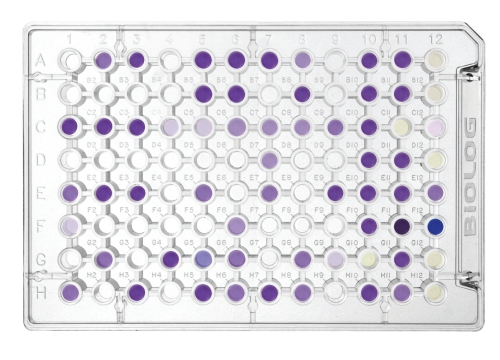
Micro Plates
Biolog's Microplates are available for :
- • Microbial Identification
- • Metabolic Characterization
- • Community Analyysis

Biolog's Microplates are available for :
Analyze an unknown microorganism with 94 simultaneous phenotypic tests. The test panel provides a “Phenotypic Fingerprint” of the microorganism that is used to identify it at the species or strain level.
All necessary nutrients and biochemicals are prefilled and dried into the 96-wells microplate. Redox dyes with colorimetric indicators enable a sensitive assay to screen the utilization of the carbon sources or resistance to inhibitory chemicals.
Biolog provide 4 types of Identification test panels as per the organism type.
Microbial Phenotype: MicroArrays, Odin can analyze up to 4,800 conditions unattended for hours or days. Phenotype MicroArray™ technology is the next step in characterization, making it possible to measure thousands of cellular phenotypes in a single experiment. Through comprehensive and precise quantitation of phenotypes, researchers can obtain an unbiased perspective of the effect on cells of genetic differences, environmental changes, and exposure to drugs or chemicals.
Mammalian Phenotype: Phenotype MicroArray Mammalian assays are cell-based assays used to investigate up to 1,400 metabolic and chemical sensitivity phenotypes.
They use 96-well plates pre-loaded with carbon and nitrogen substrates, ions, stimulatory and inhibitory compounds such as hormones/cytokines and anti-cancer agents. Cells of interest are added to the plates along with Biolog’s proprietary redox dye. The generation of energy-rich NADH by the cells reduces the redox dye and brings about a color change which can be read and analyzed by Odin.
Applications: Phenotype MicroArray Mammalian Assays can be used for research in a diverse range of applications, including-
There are 14 panels designed to interrogate metabolic pathways along with ionic, osmotic and pH effects, and 10 panels to assess the sensitivity to various antimicrobials with different mechanisms of action.
EcoPlates: Microorganisms are present in virtually all environments and are typically the first organisms to react to chemical and physical changes. Changes in microbial communities are often a precursor to changes in the health and viability of the environment as a whole.
Community-Level Physiological Profiling (CLPP) has been demonstrated to be effective at distinguishing spatial and temporal changes in microbial communities. In applied ecological research, EcoPlates™ are used as both an assay of the stability of a normal microbial population and to detect and assess changes following the onset of an environmental variable.
PreBioM plate for Gut-Microbiome Analysis: These plates consist of a curated selection of prebiotic substrates of various molecular weights designed to characterize bacterial species and their metabolic pathways. The PreBioM plates, combined with our Odin family of instruments and software, provide a high throughput phenotypic solution compatible with a wide range of species, including the obligate anaerobes inhabiting the gut microbiome as well as microbial communities.
While sequencing is often used as the standard method for defining new strains or isolates, understanding the phenotypic profile of a given microbe is key to understanding its function and the role it plays in a microbiome community. This platform allows for functional characterization to help understand how a range of different substrates support the growth of microbes or communities of interest.
040-40216185 / 85
info@swanbiotec.com